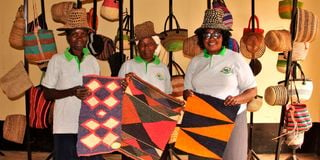Why every woman should belong to a chama

Some members of Kee Sisal Value Addition Group at their workshop in Kee Township, Makueni County on July 26, 2023. They make a living from weaving baskets, ropes, table and door mats using sisal fibre. Such groups are safe spaces where women are protected from negative gender dynamics.
What you need to know:
- Women's groups are the only source of credit for women who are excluded by the tedious and bureaucratic requirement and processes in formal financial institutions.
- Belonging to these groups provides an automatic platform for women to build and sustain social networks.
- The groups also enable women to acquire and exercise significant political power.
If you asked a Kenyan woman how many self-help groups she belongs to, you will wonder how she gets time for all of them and fulfil the financial requirements. That they do confirms the importance of these groups.
Wanjiku Kabira and Akinyi Nzioki, in Celebrating Women’s Resistance (1993), trace the origin of women’s groups to the 1960s and their consolidation to the 1970s through the Women’s Bureau, established to domesticate the United Nations Women’s Decade (1975- 1985). They note that the groups were primarily meant to enable women generate collective capacity to deal with social and economic problems, and to do things that men would not assist them with.
And what are the benefits of belonging to a women’s group? First are tangible ones that rotate around the savings. A casual observation reveals that the savings are loaned out to members to meet different needs. The process takes two forms. One is a compulsory rotational system where all the day’s collection must be loaned out from the table banking process. The second is a voluntary system where only members with need apply for and receive the money. Both ways, the group generates some income from the interest, usually 10 per cent of the principal.
Financial literacy
Classical financial experts argue that the interest does not make economic and are usurious given that it is charged on relatively small amounts repaid within a very short span of time. But they miss the bigger picture, that these group loans are the only source of credit for women who are excluded by the tedious and bureaucratic requirement and processes in formal financial institutions. It is these groups that introduce many women to financial literacy and discipline.
The physical capital the women have been able to generate through these groups include household items, real estate, cars and livestock. Through this, they subvert patriarchal barriers and chart their way towards individual and collective economic empowerment. The activities of the groups also keep money in circulation hence, stimulate local economic activities. Moreover, the income relieves women of over-dependence on husbands, which builds self-esteem, a key ingredient of human dignity.
In rural as well as urban settings, women’s groups have invested in catering services that are popular because of the convenience they provide during public events such as political rallies, funerals, religious functions and fund raisers. By providing these services, they save time and relieve event organisers of the logistical headaches of hosting such events. That these ventures create employment means the women have little urge to migrate to other places in search of formal jobs, which maintains human capital in localities and reduces urban congestion. The income derived inevitably lifts their standards of living and status, and that of their families and communities.
Psychological benefits
Beyond the physical are the social, psychological and political benefits. Belonging to these groups provides an automatic platform for women to build and sustain social networks. Solidarity with members in distress, such as bereaved ones, is a good example of the psychological benefits.
The groups also enable women to acquire and exercise significant political power. For example, they can assess political candidates to determine who best represents their interests before voting. Their modus operandi - word of mouth - makes women’s groups formidable, but silent influencers of political outcomes. Is it any wonder then that politicians fall over themselves to befriend such groups?
It will be noticed that women’s groups have distinctive dressing. Apart from the fact that these dresses are practical items that ensure dignity, the regalia also gives them visibility as a brand, which communicates that they should not, and cannot be ignored. This itself, often inspires other women to initiate similar groups. These groups must also be seen as incubators of women leaders as they create a platform for exchange of ideas, training, exposure and practical application of leadership skills.
Negative gender dynamics
From an academic perspective, women’s groups are a good demonstration of how communities can harness the five capitals in the asset pentagon in livelihoods frameworks, namely; human, social, financial, physical and natural. This is in the sense that they mobilise and apply knowledge and skills of different members (human), harness and exploit collective power (social), generate funds from themselves (financial), invest in tangible assets (physical) and contribute to environment health for those in tree farming, nurseries and organic agriculture.
These groups are safe spaces in which women are protected from negative gender dynamics, can tackle any issue without fear or inhibition and make independent decisions not incumbent on male censure or permission.
The evolution of these groups into the juggernauts they have become as development tools suggests that Kabira’s and Nzioki’s book should be updated, or new studies done on the phenomenon.
The writer is an international gender and development consultant and scholar ([email protected])





